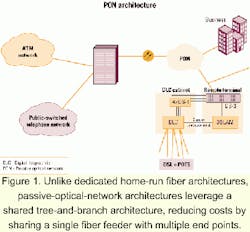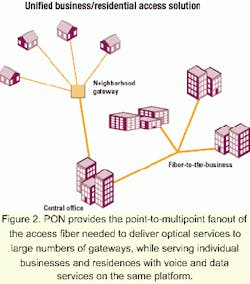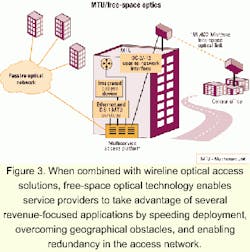Unifying the access network with fiber
Today's service providers must accommodate new technologies that optimize the intersection of copper, wireless, and optical networks to maximize tomorrow's revenues.
JOHN SMITS, Quantum Bridge Communications
"The times, they are a changin'," as the old song goes. In the past year, service providers were vaulted from the heydey of revolutionary "build it and they will come" broadband service offerings and thrust into a bitter reality where evolutionary networks leveraging their existing infrastructures provide the only road to profitability. Today, return-on-investment (ROI) is king, and maximizing ROI means striking a balance between the existing and the innovative. Only then can the new services that residential and business users need today be unleashed, paving the way for tomorrow's advances to lock in long-term profits.
In these changing times, the key to success lies in merging diverse, revenue-generating services and traffic types onto a common media-and it is abundantly clear that media is fiber. But with the range of copper, fiber, and wireless assets in today's access network and the varying needs of today's users, doing so is not a simple task.
Today's homes and businesses can be found in both single and multitenant units and need varying levels of bandwidth, protection, and pricing options. Therefore, unifying the access network with fiber means that service providers must evaluate a range of technology tools, while focusing squarely on their bottom line.
Today's communications service providers are faced with an ongoing challenge-to efficiently expand their residential service offerings in response to diverse bandwidth demands. Service providers are faced with selecting the optimal solution from a multitude of compelling alternatives such as fiber-to-the-home (FTTH) and remote DSL terminals.
The challenge: Independently, each technology fails to satisfy the immediate cost and performance constraints inherent within a service provider's business model and the diverse needs of the residential consumer market. The solution is not singular, but rather a hybrid of both fiber and copper-based technologies that delivers the right service to the right customer for the right price.
Residential communities represent a diverse demographic of homes, each demanding its own unique set of services, including plain-old telephone service (POTS), high-speed Internet access, and multimegabit video services. Within any one community, no single technology can economically satisfy all of the various customer requirements and still maximize profits for the service provider.
Some customers are willing to pay for voice service only, while others need high-speed data, video, and voice. Therefore, in some cases, if service providers want to keep costs low, they may be forced to choose a technology that only satisfies voice requirements and forego the revenues that could be generated by offering high-bandwidth services.
Alternatively, the service provider might provide very-high-bandwidth services for all users to capture the revenue stream, while accepting the fact that costs will exceed the revenues for some percentage of customers. This dilemma results from diverse residential customer needs and the constraints of today's access solutions. Combating this problem requires a fusion of existing and new technologies that can be deployed "as needed" when the revenues to be generated justify the costs.
For existing neighborhoods, the common thread that runs within all residential communities is the copper wiring that provides basic POTS services. This maze of copper wiring is routed directly to a central office (CO) or digital-loop carrier (DLC) where it is connected into public-switched telephone network (PSTN) equipment for today's lifeline voice services.
Technologies such as asymmetric DSL provide a sufficient solution for delivering high-speed data and POTS to the residence over existing copper wires but have their limitations, namely the inability to supply sufficient data speeds over distances beyond 12,000 ft. This limitation can be ad dressed by moving the point of DSL access multiplexing (DSLAM) closer to the residence through the introduction of passive optical networking (PON). Market analyst RHK Inc. (San Francisco) predicts North American remote DSL terminals will grow rapidly from 1.8 million lines in 2001 to more than eight million lines in 2004.
A PON-based fiber infrastructure uses passive couplers in the outside plant to fan out the access fiber and serve many customers or neighborhood gateways. This passive infrastructure eliminates costly active electronics needed for signal regeneration in the outside plant, providing substantial cost savings over other SONET-based solutions.
Unlike traditional feeder technologies such as T1 (1.5-Mbit/sec) and high-bit-rate DSL, PON has the ability to scale from 1 to 100 Mbits/sec on a signal medium. This optical distribution eliminates complexities associated with the crosstalk caused by digital T1 lines in the binder distribution group. With its ability to incrementally scale bandwidth beyond the limitations of copper-based feeders, PON enables a futureproof feeder investment by removing the bandwidth ceiling.Using in-field multiplexing within remote terminals or neighborhood gateways, PON-fed ADSL can deliver speeds up to 8 Mbits/sec (per ANSI T1.413) over the existing copper infrastructure. In-field multiplexing reduces the traversed distance for ADSL from the customer premises to the DSLAM, thus increasing bandwidth capacity and resolving common installation complexities.
This aggregation is typically achieved within an outdoor neighborhood gateway, ideally equipped with a next-generation DLC that provides both voice and data aggregation or an environmentally hardened DSLAM. When compared with traditional remote-terminal back-haul or feeder technologies, PON provides a superior ability to reduce costs, remove the bandwidth ceiling, eliminate a CO's fiber rats nest, and enable opportunistic deployment.
Unlike dedicated home-run fiber architectures, PON leverages a shared tree-and-branch architecture (see Figure 1). This feature reduces costs by sharing a single fiber feeder with multiple end points and reduces the fiber rat's nest associated with other point-to-point architectures. Thus, PON provides the point-to-multipoint fanout of the access fiber needed to deliver optical services to large numbers of gateways, while serving individual businesses and residences with voice and data services on the same platform.
That allows service providers to incrementally deliver fiber-based services directly from the existing fiber feed to new opportunities-be it homes or businesses. This "opportunistic" approach enables service providers to have the most efficient solution today and the flexibility to address new opportunities tomorrow.This opportunistic optical access solution outfits service providers with today's hybrid DSL solutions with a scalable architecture ideal for migrating to fiber-to-the-home. The availability of a copper plant grants service providers the flexibility to deliver both POTS and DSL services without burdening the overall network with the higher costs of optical transceivers for every residence, regardless of the level of service requested. Rather, as demand permits-optical-based broadband services can be "turned on" to those residences requiring services beyond 8 Mbits/sec. This approach directly applies FTTH cost economics to the individual consumer willing to pay for new services, maximizing ROI (see Figure 2).
In cases where multiple residential or business users reside in the same building, a very specific set of needs evolves. Because buildings are wired with a range of media, including Category 1, 3, and 5 wiring, as well as fiber, a diverse solution set may be needed to serve users within multitenant units (MTUs). As with residential offerings, today's most economical and futureproof design for serving MTUs often lies in a hybrid solution that combines the old and new to serve tenants' needs, while unifying the access network with fiber.One example can be found in MTUs equipped with Category 1 or 3 copper wiring, which is unsuitable for high-speed Ethernet. By feeding these MTUs with a PON, service providers can deploy a DSLAM in the basement to deliver high-speed data and voice services up the riser to serve every tenant in the building. Similar to the residential hybrid PON DSL solution, service providers can enjoy the flexible bandwidth and futureproof scalability of optical access, while allowing service providers to maximize the building's existing infrastructure to deliver revenue-generating, high-bandwidth voice and data services.
Many modern MTUs are outfitted with Category 5 wiring, which is ideal for high-speed Ethernet delivery and gives service providers greater flexibility in tenant services. In this case, a multiservice access platform (MSAP) may be employed to deliver high-speed, high-value voice and data offerings up the riser, such as virtual local-area network (VLAN) or transparent local-area network (TLAN) services.
The MSAP also enables a number of connectivity options that optically connect the MTU to both the CO and other buildings, continuing to unify the access network. One such option allows several MTUs to be connected with the CO via a survivable network link, providing a protected, high-profit offering for the transport of mission-critical data under stringent service-level agreements (SLAs). MSAPs may also allow use of the MTU's basement as a "virtual point of presence (PoP)," a launch pad for PON to serve businesses in the vicinity of the building.
While the unification of copper and fiber-based technologies brings with it a myriad of revenue-generating service opportunities, we are now beginning to see the many advantages of melding fiber and free-space optical systems (see Figure 3). When combined with wireline optical access solutions, free-space optical technology enables service providers to take advantage of several revenue-focused applications by speeding deployment, overcoming geographical obstacles, and enabling redundancy in the access network.
By serving as a high-capacity WAN uplink to remote optical systems, free-space optics provides significant time-to-market advantages and reduces opportunity costs by quickly bridging the gap between fiber-rich environments and a carrier's PoP. That allows service providers to uncover new revenue opportunities by rapidly bringing voice and data services to geographically dispersed businesses and MTUs. This combination also enables diverse routing and disaster recovery for low-cost network protection, allowing carriers to quickly deploy a survivable infrastructure that prevents downtime and further ensures that SLAs are met.
In today's competitive environment, service providers must have a laser focus on revenue and ROI. As the benefits of optical technology spread from the core to the metro to the access network, a slew of new and existing technologies are at work to drum up profits by touching a broad range of end users with high-value services. Today's challenge lies in accommodating these technologies by optimizing the intersection of the copper, wireless, and optical networks to maximize ROI today and guarantee revenues tomorrow.
John Smits is a business development analyst at Quantum Bridge Communications (Andover, MA). He can be reached via the company's Website, www.quantumbridge.com.



